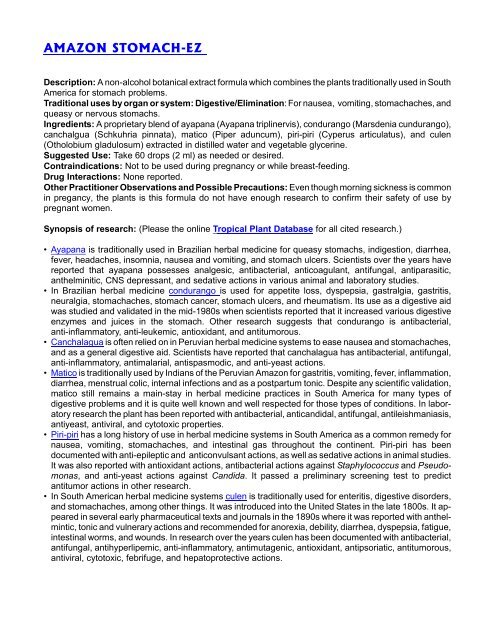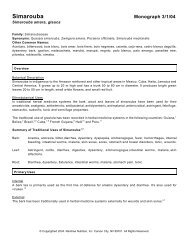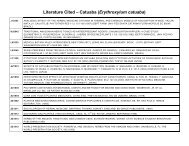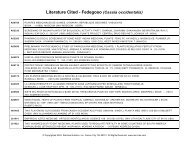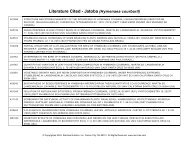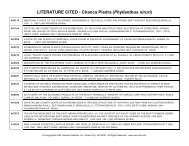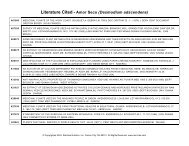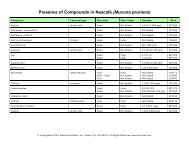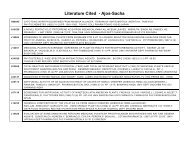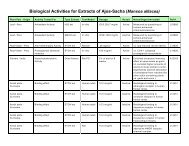Organ Specific Guide - Raintree Nutrition, Inc
Organ Specific Guide - Raintree Nutrition, Inc
Organ Specific Guide - Raintree Nutrition, Inc
You also want an ePaper? Increase the reach of your titles
YUMPU automatically turns print PDFs into web optimized ePapers that Google loves.
AMAZON STOMACH-EZ<br />
Description: A non-alcohol botanical extract formula which combines the plants traditionally used in South<br />
America for stomach problems.<br />
Traditional uses by organ or system: Digestive/Elimination: For nausea, vomiting, stomachaches, and<br />
queasy or nervous stomachs.<br />
Ingredients: A proprietary blend of ayapana (Ayapana triplinervis), condurango (Marsdenia cundurango),<br />
canchalgua (Schkuhria pinnata), matico (Piper aduncum), piri-piri (Cyperus articulatus), and culen<br />
(Otholobium gladulosum) extracted in distilled water and vegetable glycerine.<br />
Suggested Use: Take 60 drops (2 ml) as needed or desired.<br />
Contraindications: Not to be used during pregnancy or while breast-feeding.<br />
Drug Interactions: None reported.<br />
Other Practitioner Observations and Possible Precautions: Even though morning sickness is common<br />
in pregancy, the plants is this formula do not have enough research to confirm their safety of use by<br />
pregnant women.<br />
Synopsis of research: (Please the online Tropical Plant Database for all cited research.)<br />
• Ayapana is traditionally used in Brazilian herbal medicine for queasy stomachs, indigestion, diarrhea,<br />
fever, headaches, insomnia, nausea and vomiting, and stomach ulcers. Scientists over the years have<br />
reported that ayapana possesses analgesic, antibacterial, anticoagulant, antifungal, antiparasitic,<br />
anthelminitic, CNS depressant, and sedative actions in various animal and laboratory studies.<br />
• In Brazilian herbal medicine condurango is used for appetite loss, dyspepsia, gastralgia, gastritis,<br />
neuralgia, stomachaches, stomach cancer, stomach ulcers, and rheumatism. Its use as a digestive aid<br />
was studied and validated in the mid-1980s when scientists reported that it increased various digestive<br />
enzymes and juices in the stomach. Other research suggests that condurango is antibacterial,<br />
anti-inflammatory, anti-leukemic, antioxidant, and antitumorous.<br />
• Canchalagua is often relied on in Peruvian herbal medicine systems to ease nausea and stomachaches,<br />
and as a general digestive aid. Scientists have reported that canchalagua has antibacterial, antifungal,<br />
anti-inflammatory, antimalarial, antispasmodic, and anti-yeast actions.<br />
• Matico is traditionally used by Indians of the Peruvian Amazon for gastritis, vomiting, fever, inflammation,<br />
diarrhea, menstrual colic, internal infections and as a postpartum tonic. Despite any scientific validation,<br />
matico still remains a main-stay in herbal medicine practices in South America for many types of<br />
digestive problems and it is quite well known and well respected for those types of conditions. In laboratory<br />
research the plant has been reported with antibacterial, anticandidal, antifungal, antileishmaniasis,<br />
antiyeast, antiviral, and cytotoxic properties.<br />
• Piri-piri has a long history of use in herbal medicine systems in South America as a common remedy for<br />
nausea, vomiting, stomachaches, and intestinal gas throughout the continent. Piri-piri has been<br />
documented with anti-epileptic and anticonvulsant actions, as well as sedative actions in animal studies.<br />
It was also reported with antioxidant actions, antibacterial actions against Staphylococcus and Pseudomonas,<br />
and anti-yeast actions against Candida. It passed a preliminary screening test to predict<br />
antitumor actions in other research.<br />
• In South American herbal medicine systems culen is traditionally used for enteritis, digestive disorders,<br />
and stomachaches, among other things. It was introduced into the United States in the late 1800s. It appeared<br />
in several early pharmaceutical texts and journals in the 1890s where it was reported with anthelmintic,<br />
tonic and vulnerary actions and recommended for anorexia, debility, diarrhea, dyspepsia, fatigue,<br />
intestinal worms, and wounds. In research over the years culen has been documented with antibacterial,<br />
antifungal, antihyperlipemic, anti-inflammatory, antimutagenic, antioxidant, antipsoriatic, antitumorous,<br />
antiviral, cytotoxic, febrifuge, and hepatoprotective actions.


